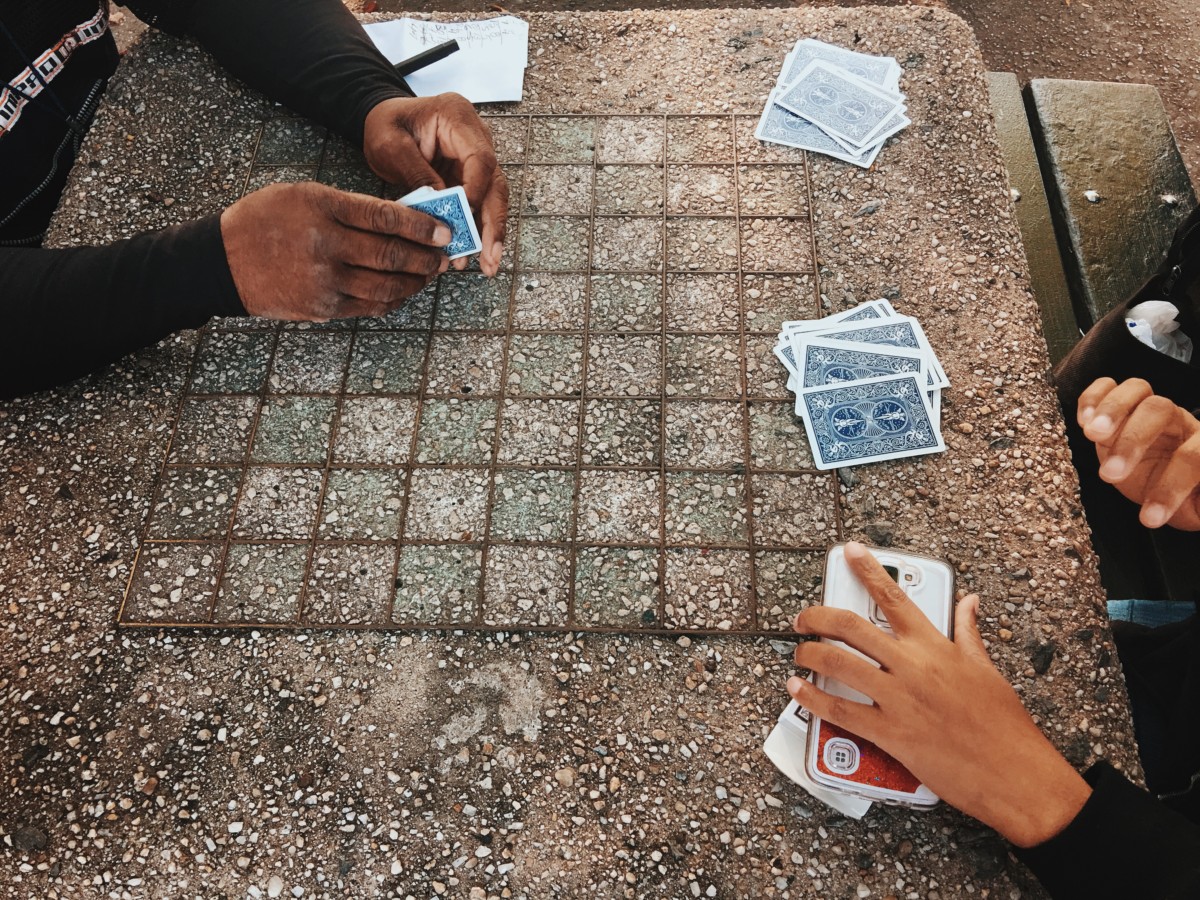It was 1 p.m. on a sunny afternoon in Herbert Von King Park in Bedford-Stuyvesant. To the left sat 63-year-old Country, a longtime Bed-Stuy resident. “I’m Country,” he said. “Call me Country.”
Country and his three friends sat on a park picnic table playing cards. He is from North Carolina but Randy, one of his friends, said, in between laughs, “You deal like you from Iowa.” The friends sat slapping cards on the table at a park across the street from the New York Police Department’s 79th precinct. It was a short physical distance but the gap between the police and the community often seems large.
Country moved to Bed-Stuy in 1966 and said he has seen little improvement in the relationship between the NYPD and the Bed-Stuy community: “They treat the community badly. They don’t want to listen. They just jump to the offensive whenever something in the community goes bad. They don’t police right. It’s the same bullshit.”
As he thought back to his more youthful days, Country said he recalled finer times with the police. “It was better years ago. There was a police officer at every school and every kid knew the police by name. Kids would respect the police because we knew them and they knew us.”
The recently appointed New York City Police Commissioner, James P. O’Neill, has instituted a “Community Policing” policy that aims to try to bring back some of that familiarity between the police officers and citizens. O’Neill’s philosophy of community policing is detailed on the NYPD website, where it says he believes that “Fighting crime is what we get paid to do…But we can’t do that unless we achieve full partnership with the community. Unless we have that connectivity, it’s not going to work.”
Officer Dennis Walsh of the 79th precinct, working in community affairs, highlighted some of the ongoing efforts in the NYPD, notably the introduction of a new police role called the Neighborhood Coordination Officers (NCOs), who are part of a larger plan called “The Way Forward,” on the NYC.Gov official website.
Walsh explained the NCOs role this way: “Two cops are assigned to neighborhoods and are supposed to be familiar with what’s going on inside their sector. They are assigned to the same sector always. They get comfortable, know what’s going on there, pay more attention to it, closely, and get more personal with what’s going on.” If something happens, he said, “Instead of calling 911, they are able to go in.”
In short, he said The NCOs are in place to ensure a more personal approach to policing. “We are still getting into it,” he said, “Its new.”
Some members of the Bed-Stuy community believe the program’s goals will prove difficult because so many people remain reluctant to trust officers.
Country, for example, said that when a citizen gets out of hand, locals are afraid to call the police for fear that they will make things worse. “Now, the police do whatever they want. There’s no shooting to wound, it’s shooting to kill. If there’s a problem at home and we call the police for help they don’t even help. When situations get tense for us, we don’t want them dead we want them detained.”
Randy chimed in, “Make sure you write that down—that we don’t call the police because we’re scared of them! Write that down!”
Alfonso Mays, another Bed-Stuy resident in the group, said, “There should be a better solution than us ending up in the precinct. We’ll be sitting here socializing and someone from over there,” he said, pointing to the 79th precinct, “will come over here.” Mays lifts up his water bottle. “You see this clear as day is water. They’ll come here and wanna smell it, and its just nonsense. If I’m drinking beer they’ll be here in one minute. But if I get shot they’ll be here in a half hour.”

The racialization of crime as Mays describes is mirrored in statistics. In its 2015 90%: The Harm Continues report, the Police Reform Organizing Project (PROP), a New York City based organization that aims to “expose and correct abusive police tactics that routinely and disproportionately do harm to [the] city’s low-income communities and people of color,” found that of the 524 criminal court cases in Manhattan, Brooklyn, and the Bronx, from May 22, 2015 to August 11, 2015, “484, or 90%, of the defendants were people of color.” PROP reports that, “According to NYPD statistics, 94.4% of juvenile arrests in 2014 involved African-American or Latino young people.”
One police tactic that has caused tensions between the police and members of the community in the past is what is called stop-and-frisk, which is still used a “tool,” as described by Walsh, by the NYPD today. According to the NYPD 2015 Stop, Question and Frisk data reports, “The most frequent race/ethnic group within the Stop Question and Frisk subject population is Black, accounting for (54.2%). Hispanic subjects account for an additional (29.2%) while White and Asian/Pacific Islanders account for (11.2%) and (5.1%) of total Stops respectively.”
The numbers of people affected by stop and frisk operations, however, have decreased drastically. The New York Daily News reported in June 2015 that, “Stop-and-frisk encounters are on pace to plunge by 42% this year, with 20,000 fewer street stops.… 11,652 stops across the city through June 3 — projecting to roughly 28,000 for the year.” On August 12, 2013, U.S. District Court Judge Shira Scheindlin ruled against the “stop-and-frisk tactics of the New York Police Department,” stating that they “violated the constitutional rights of minorities in the city,” as reported by The New York Times.
Rulings like these and the welcoming of new leaders in policing, such as Commissioner O’Neill, leave some Bed-Stuy residents hopeful. “I have hopes in it getting better,” said Country. “Different leaders are coming in.”



Leave a Reply